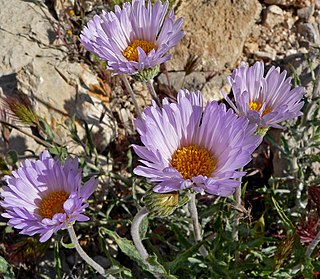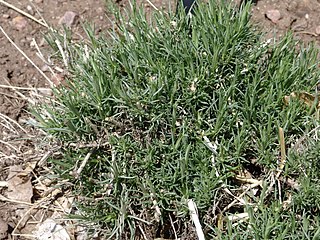
Ericameria is a genus of North American shrubs in the family Asteraceae.

Ericameria nauseosa, commonly known as chamisa, rubber rabbitbrush, and gray rabbitbrush, is a shrub in the sunflower family (Aster) found in the arid regions of western North America.

Chaenactis is a genus of plants in the family Asteraceae which are known generally as pincushions and dustymaidens.

Xylorhiza is a genus of flowering plants in the family Asteraceae, known as woodyasters. These are daisylike wildflowers usually having blue to purple or white ray flowers with yellow centers of disc florets. Woodyasters are native to western North America.

Balsamorhiza is a genus of plants in the family Asteraceae known commonly as balsamroots. These are perennials with fleshy taproots and caudices bearing erect stems and large, basal leaves. Atop the tall stems are showy yellow sunflower-like blooms. Balsamroots are native to western North America.

Hymenopappus filifolius is a North American species of flowering plant in the daisy family known by the common names fineleaf hymenopappus and Columbia cutleaf. It is native to western and central North America from Alberta and Saskatchewan south as far as Chihuahua and Baja California.

Chaetopappa ericoides is a species of flowering plant in the family Asteraceae known by the common names rose heath and heath-leaved chaetopappa. It is native to the southwestern and western Great Plains regions of the United States, plus northern Mexico. It is found in California, Nevada, Arizona, Utah, New Mexico, Colorado, Wyoming, Texas, Oklahoma, Kansas, Nebraska, Chihuahua, Coahuila, Sonora, Durango, Zacatecas, San Luis Potosí, and Nuevo León.

Chrysothamnus viscidiflorus is a species of shrub in the family Asteraceae of the Americas known by the common names yellow rabbitbrush and green rabbitbrush.

Cirsium scariosum is a species of thistle known by the common names meadow thistle, elk thistle and dwarf thistle. It is native to much of western North America from Alberta and British Columbia, south to Baja California. There are also isolated populations on the Canadian Atlantic Coast, on the Mingan Archipelago in Québec, where it is called the Mingan thistle.

Crepis occidentalis is a North American species of flowering plant in the family Asteraceae known by the common names western hawksbeard, or largeflower hawksbeard. It is native to western Canada and the western United States.

Eucephalus is a genus of North American flowering plants in the family Asteraceae.
Chrysothamnus molestus is a species of flowering plant in the family Asteraceae known by the common names Arizona rabbitbrush, Tusayan rabbitbrush, disturbed rabbitbrush, and stickyfruit low rabbitbrush. It is endemic to the State of Arizona in the southwestern United States, where it is known from Coconino, Apache, and Navajo Counties.

Ericameria parryi is a species of flowering plant in the family Asteraceae known by the common name Parry's rabbitbrush. It is native to much of the western United States.

Brickellia microphylla, the littleleaf brickellbush, is a flowering plant species in the family Asteraceae native to western North America.

Brickellia oblongifolia, the Mojave brickellbush, is North American species of plants in the family Asteraceae. It is widespread across arid and semi-arid regions in the western United States and Canada, from British Columbia south to southern California, Arizona, and New Mexico.

Lorandersonia baileyi, is a North American species of flowering plants in the tribe Astereae within the family Asteraceae. It was initially discovered in the Guadalupe Mountains of New Mexico in 1902, and has since been collected in Arizona, Utah, Colorado, Kansas, Oklahoma, Texas, Chihuahua, Coahuila, and Nuevo León.

Chrysothamnus depressus called long-flowered rabbitbrush, is a North American species of flowering plants in the tribe Astereae within the family Asteraceae. It is native to the southwestern United States, the States of California, Arizona, New Mexico, Nevada, Utah, and Colorado. It grows in dry canyons, rocky crevices and similar habitats in the Mohave Desert, the Colorado Plateau, etc.

Chrysothamnus greenei, called Greene's rabbitbrush , is a North American species of flowering plants in the tribe Astereae within the family Asteraceae. It has been found in eastern California, Nevada, Arizona, New Mexico, Utah, Colorado, and southern Wyoming.
Chrysothamnus vaseyi, called Vasey's rabbitbrush, is a North American species of flowering plants in the tribe Astereae within the family Asteraceae. It has been found in Utah, Colorado, northern New Mexico, southern Wyoming, northern Arizona and eastern Nevada.

Eurybia glauca is a North American species of flowering plants in the family Asteraceae, called the gray aster. It is native to the western United States, primarily in Arizona, New Mexico, Utah, Colorado, and Wyoming, with a few populations in Idaho and Montana.

















